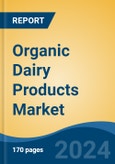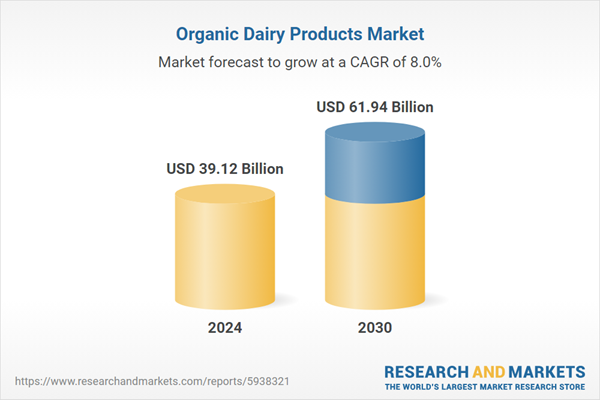Free Webex Call
The Organic Dairy Products Market was valued at USD 39.12 Billion in 2024, and is expected to reach USD 61.94 Billion by 2030, rising at a CAGR of 8.02%. The global organic dairy products market is experiencing significant growth, driven by rising consumer demand for healthier, chemical-free, and sustainably produced products. Increasing health-consciousness, concerns over the negative impact of conventional farming practices, and a growing awareness of the benefits of organic diets are key factors fueling market expansion. Speak directly to the analyst to clarify any post sales queries you may have.
10% Free customizationThis report comes with 10% free customization, enabling you to add data that meets your specific business needs.
Organic dairy products such as milk, cheese, yogurt, and butter are gaining popularity, especially in developed markets like North America and Europe. In 2024, the USDA Agricultural Marketing Service (AMS) launched the Organic Dairy Product Promotion (ODPP) program, allocating USD15 million to enhance organic dairy product availability in educational and youth programs. USDA Under Secretary Jenny Lester Moffitt announced this initiative during a visit to Vermont.
Key Market Drivers
Rising Health Consciousness
One of the major factors propelling the growth of the global organic dairy market is the increasing health consciousness among consumers. Over the past few years, people have become more aware of the potential risks associated with consuming conventional dairy products, such as the presence of pesticides, growth hormones, and antibiotics. As a result, many individuals are opting for organic alternatives, which are free from synthetic chemicals and produced using natural farming methods. U.S. sales of certified organic products reached a record USD 69.7 billion in 2023, reflecting a 3.4% increase, according to the 2024 Organic Industry Survey by the Organic Trade Association (OTA). This growth highlights rising consumer demand for organic products, driving the market for organic dairy products.Organic dairy products are often perceived as healthier because they come from cows that are not treated with growth hormones or antibiotics, and their feed is grown without the use of chemical fertilizers and pesticides. These factors align with the growing preference for clean-label products, which are seen as safer and more nutritious.
Increasing Consumer Awareness of Sustainability and Ethical Practices
Another significant driver behind the rise of the organic dairy market is the growing awareness surrounding sustainability and ethical practices in food production. Consumers are increasingly concerned about the environmental impact of food production, particularly in conventional dairy farming, which is associated with issues such as greenhouse gas emissions, overuse of antibiotics, and soil degradation due to pesticide-heavy farming practices. In contrast, organic dairy farming follows strict regulations that prohibit the use of synthetic pesticides, herbicides, and chemical fertilizers. Organic dairy farms also tend to prioritize animal welfare, providing cows with more space and access to pasture.This shift in consumer values has led to greater demand for products that align with ethical and environmental concerns. Organic dairy products are often marketed as more environmentally friendly, as organic farming practices help preserve biodiversity, reduce pollution, and improve soil health. The growing focus on sustainable and ethical food production is encouraging consumers to choose organic options, particularly in regions with higher environmental awareness, such as Europe and North America. This driver is expected to play a significant role in the ongoing expansion of the organic dairy market.
Growing Demand for Clean Label and Natural Products
The clean label movement, which emphasizes transparency and simplicity in food ingredients, is another factor driving the organic dairy market. Consumers are increasingly seeking products that are free from artificial additives, preservatives, and genetically modified organisms (GMOs). Organic dairy products, which are made without synthetic ingredients and often have fewer additives, fit well into this trend.The rise of the clean label movement is particularly strong among millennials and Gen Z consumers, who are more likely to scrutinize product labels and demand products with fewer processed ingredients. This demographic also values the natural aspect of organic products, aligning with their preference for whole, minimally processed foods. As a result, organic dairy brands are capitalizing on this demand by offering clean-label products, such as organic milk, cheese, and yogurt, which are marketed as healthier, more natural alternatives to conventional dairy. The clean-label trend is expected to continue driving the market for organic dairy products in the coming years.
Key Market Challenges
Limited Supply and Production Challenges
One of the most significant challenges in the organic dairy market is the limited supply of organic milk and other dairy products. Organic dairy farming requires strict adherence to specific standards, including the use of organic feed, animal welfare practices, and the prohibition of synthetic chemicals, which makes organic dairy farming more complex and resource-intensive compared to conventional farming. These regulations limit the number of farms able to transition to organic practices, creating a supply-demand imbalance.Furthermore, the certification process for organic farms is time-consuming and expensive. Many small and medium-sized farms find it difficult to meet the stringent requirements and may not have the financial resources to undergo the certification process, limiting the number of organic dairy producers. This challenge is particularly evident in regions where organic farming infrastructure is underdeveloped or where the transition from conventional to organic farming is financially prohibitive.
Price Premiums and Affordability
A significant challenge for the global organic dairy market is the higher price point of organic dairy products compared to conventional dairy. Organic dairy products are typically more expensive due to the higher costs associated with organic farming practices, including organic feed, labor, and certification. This price premium can make organic dairy products unaffordable for a large portion of the global population, particularly in developing markets or for lower-income consumers.Consumers are often willing to pay more for organic dairy products due to perceived health and environmental benefits. However, the economic divide between those who can afford organic dairy and those who cannot remains a barrier to wider adoption, especially in price-sensitive regions. Even in developed markets, where organic products have a more established presence, the higher cost may limit the growth potential of the market as consumers may opt for more affordable conventional alternatives.
Key Market Trends
Product Innovation and Premium Offerings
Innovation is a major trend within the organic dairy market, with companies focusing on diversifying their product offerings to cater to evolving consumer preferences. There is an increasing demand for new organic dairy products that cater to specific dietary needs, such as lactose-free, low-fat, high-protein, and fortified options. For instance, organic dairy products enriched with omega-3 fatty acids, probiotics, and vitamin D are gaining traction among health-conscious consumers looking for functional foods that provide additional health benefits.Companies are also investing in premium product lines, with some brands offering organic dairy products sourced from rare breeds of cows or specialty organic farms that adhere to particularly stringent practices. For example, premium organic cheeses, yogurt, and milk are gaining popularity due to their perceived higher quality and health benefits. These products often come with higher price tags, but they appeal to affluent consumers who are willing to pay more for superior quality, authenticity, and sustainability.
Rising Demand for Plant-Based Alternatives
A prominent trend in the organic dairy market is the increasing demand for plant-based dairy alternatives. Consumers are shifting toward plant-based diets due to concerns about health, lactose intolerance, vegan lifestyles, and environmental sustainability. These plant-based alternatives, such as almond milk, soy milk, oat milk, and coconut-based products, are becoming increasingly popular due to their perceived health benefits and environmental appeal.As a result, traditional dairy companies are diversifying their product portfolios to include organic plant-based dairy alternatives. This shift is also fueled by the growing consumer demand for non-dairy substitutes in organic food offerings. Major players in the dairy industry are exploring innovation by creating hybrid products, such as organic dairy and plant-based blends, to cater to both traditional dairy consumers and those seeking plant-based alternatives.
Segmental Insights
Sales Channel Insights
Supermarkets and hypermarkets was the dominating segment in the global organic dairy products market, driven by their widespread accessibility and convenience. These retail channels provide consumers with a diverse range of organic dairy products under one roof, catering to the increasing demand for healthier and more sustainable food options. The availability of organic dairy items in large quantities and the ability to compare prices make supermarkets and hypermarkets the preferred shopping destination. Additionally, these stores often have dedicated organic sections, which further support the growth of organic dairy consumption, making it easily accessible to a broad consumer base.Regional Insights
North America was the dominating region in the global organic dairy products market, driven by increasing consumer awareness of health benefits and sustainability. The U.S. and Canada have seen significant growth in demand for organic dairy products due to rising health-consciousness and preference for ethically produced, hormone-free products. Stringent regulations and certification standards further support the market’s expansion in the region. Additionally, strong retail networks, including natural food stores and e-commerce platforms, make organic dairy products easily accessible to consumers. The growing trend of sustainability and animal welfare also fuels North America's leading position in the global organic dairy market.Key Market Players
- Acorn Dairy Ltd.
- Andechser Molkerei Scheitz GmbH
- Arla Foods Group
- Aurora Organic Dairy
- Fonterra Co-operative Group Limited
- Barambah Organics Operations Pty Ltd
- China Shengmu Organic Milk Limited
- Danone S.A.
- General Mills Inc.
- Organic Producer Pools (Organic Valley)
Report Scope:
In this report, the Global Organic Dairy Products Market has been segmented into the following categories, in addition to the industry trends which have also been detailed below:Organic Dairy Products Market, By Type:
- Organic Milk
- Organic Cheese
- Organic Yogurt
- Organic Butter
- Others
Organic Dairy Products Market, By Packaging Type:
- Pouches
- Tetra-packs
- Bottles
- Cans
- Others
Organic Dairy Products Market, By Sales Channel:
- Supermarkets/Hypermarkets
- Specialty Stores
- Online
- Others
Organic Dairy Products Market, By Region:
- North America
- United States
- Canada
- Mexico
- Asia-Pacific
- China
- Japan
- India
- Australia
- South Korea
- Indonesia
- Europe
- France
- United Kingdom
- Italy
- Germany
- Spain
- South America
- Argentina
- Colombia
- Brazil
- Middle East & Africa
- South Africa
- Saudi Arabia
- UAE
- Turkey
Competitive Landscape
Company Profiles: Detailed analysis of the major companies present in the Global Organic Dairy Products Market.Available Customizations:
With the given market data, the publisher offers customizations according to a company's specific needs. The following customization options are available for the report.Company Information
- Detailed analysis and profiling of additional market players (up to five).
This product will be delivered within 1-3 business days.
Table of Contents
1. Introduction
2. Research Methodology
3. Executive Summary
4. Voice of Customers
5. Global Organic Dairy Products Market Outlook
6. North America Organic Dairy Products Market Outlook
7. Asia Pacific Organic Dairy Products Market Outlook
8. Europe Organic Dairy Products Market Outlook
9. South America Organic Dairy Products Market Outlook
10. Middle East & Africa Organic Dairy Products Market Outlook
11. Market Dynamics
12. Impact of COVID-19 on Global Organic Dairy Products Market
14. Competitive Landscape
15. Strategic Recommendations/Action Plan
Companies Mentioned
- Acorn Dairy Ltd.
- Andechser Molkerei Scheitz GmbH
- Arla Foods Group
- Aurora Organic Dairy
- Fonterra Co-operative Group Limited
- Barambah Organics Operations Pty Ltd
- China Shengmu Organic Milk Limited
- Danone S.A.
- General Mills Inc.
- Organic Producer Pools (Organic Valley)
Table Information
| Report Attribute | Details |
|---|---|
| No. of Pages | 181 |
| Published | February 2025 |
| Forecast Period | 2024 - 2030 |
| Estimated Market Value ( USD | $ 39.12 Billion |
| Forecasted Market Value ( USD | $ 61.94 Billion |
| Compound Annual Growth Rate | 8.0% |
| Regions Covered | Global |
| No. of Companies Mentioned | 10 |









